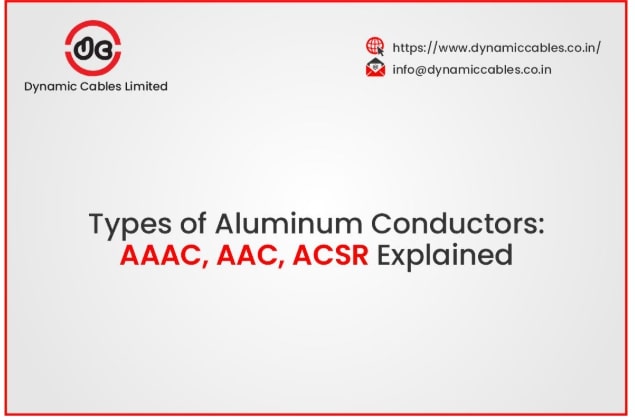- An ISO 9001:2015, 14001:2015 & 45001:2018 Company

Types of Aluminum Conductors: AAAC, AAC, ACSR Explained
In the extensive web of overhead power transmission and distribution lines that cover our landscapes, selecting conductor material is critical to efficiency, reliability, and economy. Aluminum has become the prevailing material because of its superior conductivity-to-weight ratio and cost. Yet, not all aluminum conductors are the same. Various aluminum conductors have been designed to maximize performance for particular applications. This blog will explore the most critical features, benefits, and uses of three leading forms: AAAC conductors, AAC (All Aluminum Conductor), and ACSR (Aluminum Conductor Steel Reinforced), with observations from top electrical cable wire producers such as Dynamic Cables.
AAC: The Root - All Aluminum Conductor
As the name implies, AAC has one or more strands of high-purity aluminum wires. It has good conductivity and is light in weight, thus being a low-cost solution for most distribution lines, especially in rural localities and short spans. Its simplicity in construction also makes it easier to handle and install.
However, the biggest drawback of all aluminum conductors is their comparatively lower tensile strength. This limits its application to long spans or zones subject to heavy ice or wind loads since it can sag too much or even fracture when subjected to significant stress. Though it has a high conductivity per unit weight, its mechanical strength usually requires shorter spans and more considerable support structures, which can be costly in some situations. However, AAC is still a feasible alternative for usage where mechanical stress is low and cost is of utmost importance. Reliable cable manufacturers in India, such as Dynamic Cables, provide an assortment of high-quality AAC conductors.
ACSR: Strength and Conductivity Combined - Aluminum Conductor Steel Reinforced
To overcome the shortfall of AAC when it comes to tensile strength, ACSR conductors came into being. These conductors have a central core of steel strands with superior strength covered in layers of strands of aluminum. The steel core gives the strength required to help the conductor hold up against very high tensile stresses, facilitating longer spans without supports, particularly in high-tension transmission systems and heavy-loaded areas.
The aluminum wires in ACSR conductors carry the electrical current, taking advantage of the superior conductivity of aluminum. By harnessing steel's mechanical strength and aluminum's electrical effectiveness, ACSR provides a best-of-both-worlds solution for long-distance, high-power transmission. The steel core may differ in the number and composition of strands according to the particular strength needs of the application. Electric cable wire manufacturers such as Dynamic Cables create several configurations of ACSR to support a range of transmission line structures and conditions. Although ACSR provides better strength than AAC, including steel makes it heavier and perhaps more prone to corrosion unless it's protected.
AAAC: The Alloy Advantage - All Aluminum Alloy Conductor
AAAC conductors are yet another step in aluminum conductor technology. Rather than pure aluminum, AAAC is composed of a particular aluminum alloy that usually includes magnesium and silicon. This has a dramatic effect on the mechanical properties of the conductor, giving it greater tensile strength and a more favorable strength-to-weight ratio than both AAC and, in certain situations, even ACSR for the same conductivity.
The greater strength of AAAC conductors enables longer spans, less sag, and better performance under high-loading conditions, frequently with fewer supporting structures than AAC. Additionally, all aluminum alloy conductors have better corrosion resistance than AAC and the steel core of ACSR. This renders AAAC a favorable option in coastal regions or industrial environments with corrosive atmospheres, resulting in a longer lifespan and lower maintenance costs.
Though the electrical conductivity of aluminum alloys is a bit lower than that of pure aluminum, the improved mechanical properties and corrosion resistance frequently make AAAC conductors the best choice for most medium and high-voltage transmission and distribution lines. They provide an attractive combination of strength, conductivity, and durability. Top cable producers in India, like Dynamic Cables, understand the advantages of AAAC and offer a range of these conductors to suit the changing needs of power infrastructure.
Selecting the Right Conductor: A Matter of Application
The choice of the right aluminum conductor type – AAC, ACSR, or AAAC – is dependent on the particular needs of the power line project. Considerations like span length, voltage level, weather conditions (wind, ice, corrosion), and cost all determine the choice.
AAC is usually acceptable for shorter distribution spans in areas with little mechanical stress and where cost is the primary consideration.
ACSR is the heavy lifter of long-distance, high-voltage transmission lines where tensile strength is essential.
AAAC provides an attractive combination of strength, conductivity, and corrosion resistance, making it a good option for medium to high-voltage lines, especially in severe environmental conditions or where longer spans are required without the weight penalty of ACSR.
In summary, it is essential for engineers and project planners undertaking power transmission and distribution to comprehend the unique properties of AAAC conductors, all aluminum conductors (AAC), and ACSR conductors. Reliable electrical cable wire manufacturers and Indian cable manufacturers such as Dynamic Cables offer various conductors, each designed to serve particular performance specifications. By meticulously examining the application and weighing the trade-off among strength,conductivity, weight, and corrosion resistance, the best aluminum conductor can be chosen to guarantee a stable and efficient power delivery system.
 English
English

 C701, Tower-C, Noida One
C701, Tower-C, Noida One
